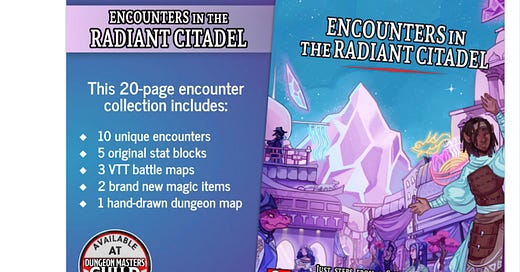TL;DR: I’m writing a project management series for TTRPGs! This post introduces the format of the series and why collaboration is awesome.
Back in October, I released Encounter in the Radiant Citadel with a fantastic team of collaborators (see the end of this post).
I’ve project managed in professional (online courses for Google) and personal (cooperative houses) settings, but this was the first TTRPG project I’d managed and my first DMsGuild title.
This series is about paying it forward and sharing what I learned. I am not a multi-award-winning TTRPG writer/manager (yet…) but Encounters did hit copper within 48 hours and was in the #1 position for “Most Popular DMs Guild Titles Under $5”. More importantly, my co-collaborators were proud to have worked on the project, as evidenced by the 4.6/5 happiness rating the project got (yes, I did happiness/feedback surveys).
(Also, this doesn’t necessarily speak to my project management skills, but this combo Ajit George-Matt Mercer re-tweet briefly fried my brain)
What this series is about
So I can’t tell you how to get retweeted by Matt Mercer, but I can share what went into the Encounters collaboration. I’ll be writing about:
Step-by-step what I did for a small (~1-month timeline) collaboration
What worked and what I’ll do differently next time
Project managing for TTRPGs specifically
Templates for documents, spreadsheets, and other processes you can pick up and use for your own TTRPG collaborations
If this sounds interesting, stay up to date by subscribing, and let me know if there’s a particular topic you want me to touch on in the comments:
Working alone is hard…
After self-publishing my first game, Jukebox, I realized that if I kept working alone, I would burn out. It took three years, working in little bursts on nights and weekends, to get it to its publishable form and involved begging close friends to playtest and copy-edit it. I did the layout and all of the writing alone. All of the energy for the project I had to manifest into the world. Jukebox made $80 and quickly disappeared off of the front page of itch.io and DriveThruRPG. How long would I really be able to design games and throw them into the void of the internet? It wasn’t sustainable (at least not for me).
“BUT, but!”, I thought, “if I had just two or three other people, people I really trusted working with me, I could see getting into a rhythm with writing”. Heck, I’d run D&D campaigns for years.
As a newbie to game publishing, it was going to be a huge struggle to get hired onto a dream team, so if I wanted to work on a project like that, I needed to make it myself.
Working with others is great!
There are a bunch of benefits to working collaboratively:
Someone cares: Someone else cares about the work you’re creating and it being successful.
Feedback: You can swap feedback and editing in a way that isn’t asking for free labor from friends and family. (Thanks Josh for proofreading this post).
Play to people’s strengths: Everyone gets to bring their A-game. You can play to people’s strengths.
Learning: You get to learn from how other people work and pick and choose strategies that make your own work better.
Helps you survive promotion: Hate even thinking about self-promotion? It’s usually easier to talk about how great a collaborator is without feeling like all of your organs are rejecting you and wanting to slide into the earth. Also, it helps to get traction and end up on the front page of “certain websites” if you have more people promoting your work.
Networking: I am not a networking pro (see comment about self-promotion making me want to slide into the earth). But I figured that if I do actual work with 9 other people and it goes well, I now have a network of 9 people who can vouch for me. And if any of them “make it”, there’s a chance they’ll remember that cool project we worked on. This seems like a more fun way to go about writing than 1. Trying to convince someone to take a chance on you who doesn’t know you 2. Publishing a bunch of content alone and hoping that someone will notice you’re a diamond in the rough.
There are also a plethora of other creators who have espoused the virtues of working collaboratively, such as Justice’s Guide to the DMs Guild which lists finding collaborators as one of the first “tips”.
Speaking of collaborators, here are the lovely folks I worked with: John Cardoso, Grace DeMeo (our talented cover artist), Nick Donovan, Aaron Gable, Lucas Gobert, Taylor Navarro, Léon Othenin-Girard, Ryan Phillips, Jason Bradley Thompson, and Brooke Whitney (recently released Temple of Lies). Work with them! Hire them!
Next up, I’ll share a bit about “getting ready” to collaborate, including the tools and websites I used to get started. In the meantime, happy holidays!
Over and Out,
- 🫙 👁️ 👁️



